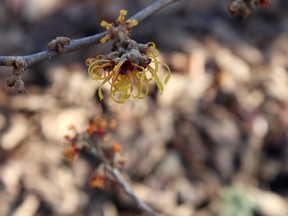The temperature dip is not severe, but it is cold enough to stop plants from developing leaves and buds from swelling

With overnight lows set to plummet to below zero starting Friday, Metro Vancouver gardeners may be fretting about the fate of their plants and vegetable crops after what has been a mostly mild winter.
And with good reason.
Last January, a deep freeze in Okanagan region decimated crops and proved catastrophic for farmers and winemakers. In Metro Vancouver, frigid temperatures threatened plants and garden plots, leaving some plants or trees bare of buds or with discoloured foliage.
What should gardeners do to prepare for the cold weather?
Master gardener Brian Minter has a tip for most gardeners: Do nothing.
“We really need this to happen,” said Minter of the upcoming cold snap, noting that mild temperatures have already triggered winter budding in some trees.
The temperature dip is “not severe cold, but it is cold enough to stop plants from developing leaves and buds from swelling,” he said. “This is great. It’ll stop them in their tracks.”
Plants that are within the region’s hardiness zones (zone 7 for Metro Vancouver and zone 6 in the eastern Fraser Valley) will be OK.
I have container plants. What should I do?
Horticulturalist Christina Chung of Fluent Garden isn’t too worried about most plants at these temperatures, but noted that some plants, such as those in containers or those not hardy for the region, can use extra TLC.
Container plants are susceptible to damage because their roots are above ground and exposed to harsher conditions than plants rooted in the ground.
To protect them, Chung recommends putting a layer of mulch on top of the plants and using burlap or garden fleece as insulation around the pots. If you have several small pots, huddle them together and wrap them up as a group, she suggested. Tuck the containers along a house as every little bit of heat helps.
Minter likes using an insulating cloth called N-sulate, which ameliorates the cold and stops the wind while letting plants breathe. It’s what he uses for severe cold spells and can make up to a 10 C difference, depending on the grade of insulation.
What kind of plants need cold-weather protection?
Chung, who authored The Layered Edible Garden, a book about creating productive food gardens, said fruit trees with buds that are starting to swell are especially vulnerable.
A cold spell can be disastrous to plants that are budding early. She recommends using insulation to wrap the plant or even the buds as much as possible. “Protect those guys because unfortunately, no flowers mean no fruit.”
Other plants that could use extra protection: Citrus plants, tropical plants, and those meant for warmer climates with hardiness zones of 8 or 9, and some plants that are starting to bud.
What plants will likely be OK?
There are plenty of winter blooming plants like viburnum, honeysuckle and Chinese witch hazel, said Minter.
Temperatures of about -4 C isn’t enough to harm them. “The buds may freeze a bit, but when it becomes mild, they’ll be absolutely fine.”
Our experts also said bulbs, like early blooming crocuses, snow drops, daffodils and tulips, aren’t in any danger. Neither are garlic bulbs. These cold-hardy plants should be able to tolerate colder temperatures, as can winter vegetables such as spinach, kale, Swiss chard, onions and beets.
What would you consider ideal weather for this time of year?
For Minter, the combination of seasonal temperatures periodically interrupted by frost just below 0 C is ideal.
Chung said the wide variety of plants grown in the region makes it hard to identify one ideal, but one thing she doesn’t want is drastic temperatures swings, just “something more gradual rather than these cold snaps, something a bit more of a gentle wake up.”